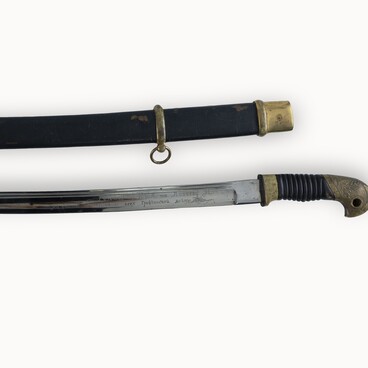The arms factory in Zlatoust was opened in 1815 to produce blade weapons for the needs of the Russian army and navy. Initially, a number of wooden facilities were built on the banks of the Ay River. The permanent stone building was completed only in 1839.
The enterprise was not formally part of the Zlatoust State-Owned Ironworks. As a rule, the mining chief of the Zlatoust Ironworks was appointed as its director. The arms factory produced a variety of types of combat, fencing and hunting weapons: sabers, broadswords, cavalry swords, smallswords, backswords, daggers, naval dirks, pikes, spadroons and knives. From 1839 to 1860, cuirasses (pieces of armor to cover the torso) were also manufactured there.
Zlatoust-made blade weapons had high combat performance and were known not only in the Russian Empire but also far beyond its borders. The first weapon decorators were the craftsmen from the city of Solingen — father and son the Schaafs. Since 1818, all weapons were decorated by Russian artists.
The works of the 1820s–1830s demonstrate the formation of a typical Zlatoust style. The blades of the period were characterized by sophisticated plot compositions. The best examples are the works of Ivan Nikolayevich Bushuyev, the founder of the Zlatoust school of steel engraving.
This blade of an officer’s smallsword of 1818 was decorated by Bushuyev in 1826. The blade was made with one wide fuller and a double-edged tip. It is decorated on both sides to the length of 35 cm.
The right flat (lateral side) of the blade has a composition applied in gold against a blue background, which consists of gilded elements of a floral ornament in the form of palm tree leaves (palmettes), five-pointed stars, and laurel branches. The central part of the composition features an image of the goddess Athena, who is drawing the monogram of Emperor Nicholas I. Both on the right and the left, there are oval stamps with images of the winged stallion Pegasus.
A similar composition features on the left flat; however, in its central part, instead of the imperial monogram, a double-headed eagle — the coat of arms of the Russian Empire — was placed. The back bears a factory mark “Zlatoust 1826” etched thereon, along with a personal mark of craftsman Bushuyev, engraved with a needle on a gilded background.
The enterprise was not formally part of the Zlatoust State-Owned Ironworks. As a rule, the mining chief of the Zlatoust Ironworks was appointed as its director. The arms factory produced a variety of types of combat, fencing and hunting weapons: sabers, broadswords, cavalry swords, smallswords, backswords, daggers, naval dirks, pikes, spadroons and knives. From 1839 to 1860, cuirasses (pieces of armor to cover the torso) were also manufactured there.
Zlatoust-made blade weapons had high combat performance and were known not only in the Russian Empire but also far beyond its borders. The first weapon decorators were the craftsmen from the city of Solingen — father and son the Schaafs. Since 1818, all weapons were decorated by Russian artists.
The works of the 1820s–1830s demonstrate the formation of a typical Zlatoust style. The blades of the period were characterized by sophisticated plot compositions. The best examples are the works of Ivan Nikolayevich Bushuyev, the founder of the Zlatoust school of steel engraving.
This blade of an officer’s smallsword of 1818 was decorated by Bushuyev in 1826. The blade was made with one wide fuller and a double-edged tip. It is decorated on both sides to the length of 35 cm.
The right flat (lateral side) of the blade has a composition applied in gold against a blue background, which consists of gilded elements of a floral ornament in the form of palm tree leaves (palmettes), five-pointed stars, and laurel branches. The central part of the composition features an image of the goddess Athena, who is drawing the monogram of Emperor Nicholas I. Both on the right and the left, there are oval stamps with images of the winged stallion Pegasus.
A similar composition features on the left flat; however, in its central part, instead of the imperial monogram, a double-headed eagle — the coat of arms of the Russian Empire — was placed. The back bears a factory mark “Zlatoust 1826” etched thereon, along with a personal mark of craftsman Bushuyev, engraved with a needle on a gilded background.





